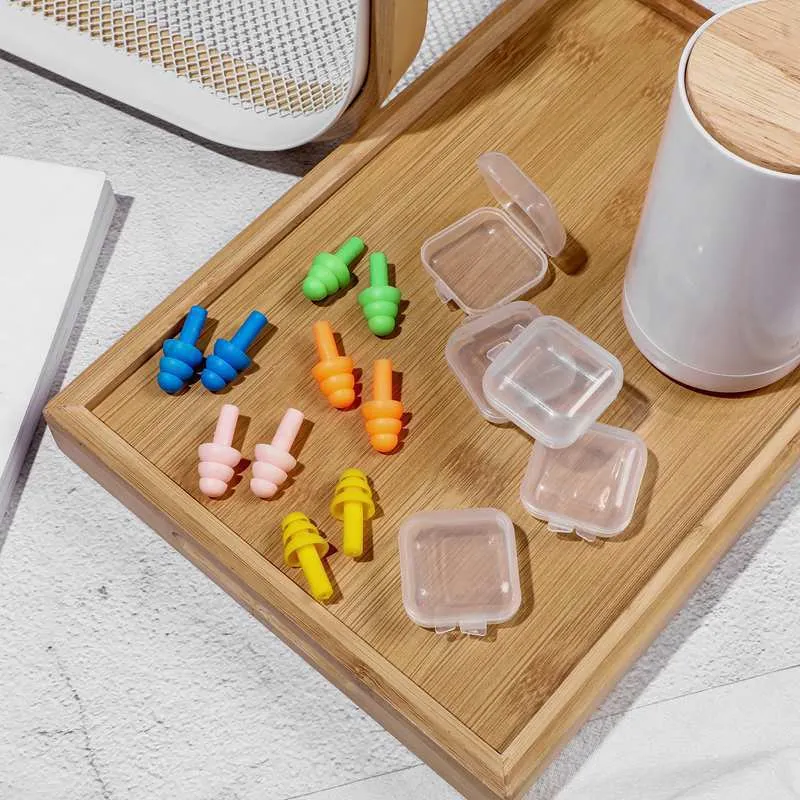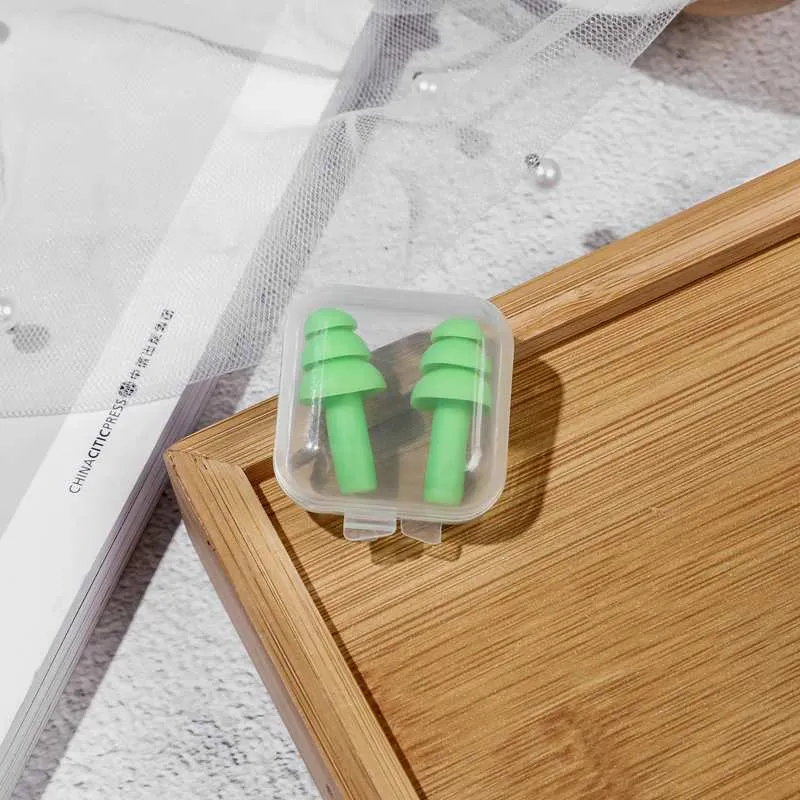Silicone ear plugs offer an effective solution for noise reduction and protection in various situations. From restful sleep to preventing hearing damage, understanding the proper use of silicone ear plugs is crucial for maximizing their benefits. This guide provides a comprehensive overview of how to use silicone ear plugs safely and effectively.

What is Silicone Ear Plugs?

Silicone earplugs are a form of hearing protection device that is put into the ear canal to limit noise exposure while also protecting the ears. They are made of a soft, flexible silicone substance that conforms to the shape of the ear, forming a seal that helps to block out sound.
One of the benefits of silicone earplugs is their softness and flexibility, which allows for a comfortable fit and reduces pain during lengthy wear. They are usually reusable and can be washed with mild soap and water for hygiene.
Silicone earplugs come in a variety of forms and sizes to suit different ear canal sizes and preferences. Some are pre-molded, while others are moldable, which means they may be sculpted and modified to fit the specific ear.
It is important to note that, while silicone earplugs can reduce noise, they do not completely eliminate it. They are intended to provide protection while also reducing noise to a safe and comfortable level.
Types Of Ear Plugs
Some earplugs are an upgraded version of those old plastic ones, which might have hurt you in the morning. Here are some comfortable options for earplugs that will be more comfortable to use:
1. Foam Ear Plugs
A foam earplug is one of the most common, as it is made of simple foam. You can use one for your ear by rolling the foam and creating the shape of your ear canal. Check if they fit in your ears, remove them, inspect them with your eyes, put them back, and go to sleep.
2. Silicone Ear Plugs
Silicone earplugs are one of the most popular ones available in the market. These are reusable, as they can be washed and used again. Washing them after every use is necessary to remove the chances of bacterial infection in your ears.
3. Wax Ear Plugs
Wax earplugs are made of wax, as you’d have imagined by the name. These earplugs come with wax and a user guide. You can take out the wax, make a small ball, and put it in your ear. Press it gently, and let it take the shape of your ear canal. Take it out, check for fit, and let it dry.
4. Flanged Ear Plugs
Flanged earplugs sound peculiar to be used in your ear, but trust me, these are just for those who like to put earplugs deeper in their ear canal. Tilt your head, pull your ear to make a straight path for the earplug, and then insert it.
How To Use Silicone Ear Plugs
Silicone earplugs are hearing protection intended to decrease exposure to loud noises that might cause hearing impairment. To use silicone earplugs properly, follow these steps below:
Raise Your Hands
Wash your hands thoroughly to avoid introducing dirt or bacteria into your ears.
Remove Roll the Earplugs
Roll the silicone earplugs between your fingers to compress them and make them simpler to place in your ear canal.
Put in the Earplugs
With one hand, reach over your head and pull your ear up and out; then, carefully insert the compressed earplugs into the ear canal.
Pull Up and Back
Gently pull the top of your ear up and back to straighten the ear canal.
Adjust the Fit
To make sure the earplugs fit snugly and comfortably, gently twist them. Then, hold them in place for a short while to let them expand and take on the shape of your ear canal.
Remove the Earplugs
Avoid yanking or jerking the earplugs out of your ears by carefully twisting and pulling them out.
When silicone earplugs get filthy, broken, or no longer fit properly, they should be replaced. Ask for assistance from a hearing health specialist if you are experiencing difficulties putting on or removing the earplugs.
Test the Seal with Your Eyes
A popular method of testing a seal is to visually inspect it, looking for any fractures, gaps, or wear and tear that would point to a failure in the seal’s capacity to stop leaks.
Doing a pressure test, which involves applying pressure to the sealed region and checking for leaks, is an additional technique. Testing using dye penetration, suction, and ultrasonic waves are a few more techniques.
Removal of Silicone Ear Plug Techniques
Removing silicone ear plugs can be done safely and easily. Here’s how:
Grasp: Gently grasp the top of the ear plug with your thumb and forefinger.
Twist and Pull: Twist the ear plug slightly while pulling it outward slowly. Avoid pulling sharply.
Clean and Store: Clean the ear plugs with a damp cloth and store them in a case to prevent contamination.
Maintaining and Cleaning of Silicone Ear Plug
Proper maintenance and cleaning extend the lifespan of silicone earplugs
Inspect Regularly: Check for any damage or wear before each use.
Clean After Use: Wipe earplugs with a damp cloth to remove dirt or debris after each use.
Periodic Deep Cleaning: Soak ear plugs in a mild soap solution for 15-20 minutes once a week to remove accumulated earwax.
Dry Thoroughly: Allow ear plugs to air dry completely before reuse.
Safety Precautions for Silicone Ear Plug
Avoid Insertion Too Deeply: Insert ear plugs only into the outer portion of the earcanal, avoiding pushing them too far in.
Wear for Limited Periods: Prolonged use of ear plugs can lead to earwax buildup. Limit daily use to 8-10 hours.
Do Not Use When Diving: Silicone ear plugs can trap water and increase the risk of ear infections when diving.
Medical Conditions: Consult healthcare professional before using ear plugs if you have any ear infections, perforations, or other medical conditions.
Common Uses of Silicone Ear Plug
Silicone ear plugs have various applications:
Noise Reduction: Sleep, studying, construction zones, noisy environments
Hearing Protection: Concerts, heavy machinery, shooting ranges
Waterproofing: Swimming and water sports
Travel: Blocking out travel noise and promoting restful sleep
Simple Guide to Using Silicone Ear Plugs
Here comes the talk about silicone earplugs, the most popular one. Silicone earplugs are simple to use. However, here are some tips that will help you wear them properly.
Sanitize Your Hands: Sanitize your hands properly, ensuring nothing infectious gets in your ear.
Roll The Earplugs: Roll the plugs with your palms between your fingers and make the plugs the size of your ear canals. You can guess the size.
Insert The Earplugs: Insert the plugs gently into your ears and fit them properly with your fingers. Make sure it fits in your ear canal perfectly.
Adjust Your Fit: Adjusting the fit is essential so the earplugs don’t come out in the middle of the night.
Remove It: Remove your earplugs properly and carefully, ensuring you are not breaking or disfiguring them. Check again whether they are a perfect fit or not.
Check For Sound: You can try to listen to any sound. If a muffled sound or no sound can be heard, then it’s a good sign.
Check For Proper Seal: You should check whether they seal your ears correctly. This will ensure that earplugs don’t come out while you sleep.
Comfortability: Check for comfortability. Use it only when you are entirely comfortable wearing these earplugs; otherwise, they will cause soreness in the morning.
Using Ear Plugs For a Quality Sleep
If you use an ear plug to get quality sleep regularly, that’s a good thing, but those plastic ones are not for extended usage. Get yourself one of those silicone earplugs; these are more comfortable and fit accordingly in your ears. There are many other options for an ear plug you get for yourself. Have a look:

How to Tell Whether Your Earplugs Were Inserted Correctly
You can try your earplugs in a noisy setting to see how well they fit. Cradling your hands over your ears is one way to accomplish this. If the earplugs fit correctly, you should not notice a difference in the noise level. You should give it another go if there is less noise while your hands are cupped over your ears. Since earplugs should not come out independently, you have probably placed them incorrectly and need to work on your technique. They need to nestle firmly inside or up against the ear canal.
Choosing the Right Ear Plugs
Selecting the appropriate silicone ear plugs depends on your specific requirements. Consider the following factors:
Noise Reduction Rating (NRR): This rating indicates the amount of noise that ear plugs can block. Higher NRR values provide greater protection.
Size and Shape: Ear plugs come in different sizes and shapes to fit various ear canals comfortably. Choose ear plugs that fit snugly without being too tight.
Material: Silicone is a hypoallergenic material that is soft and pliable, making it a comfortable option for extended wear.
Conclusion:
Using silicone ear plugs effectively requires proper selection, insertion, removal, maintenance, and safety precautions. By following the guidelines outlined in this guide, you can maximize the benefits of silicone ear plugs for noise reduction, hearing protection, and enhancing your overall well-being.